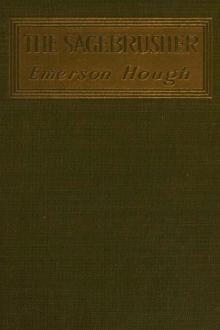The Story of the Outlaw by Emerson Hough (most read books in the world of all time .TXT) 📖

- Author: Emerson Hough
- Performer: -
Book online «The Story of the Outlaw by Emerson Hough (most read books in the world of all time .TXT) 📖». Author Emerson Hough
"This was really the dawning of the American cattle industry. The Long Trail now received a gradual but unmistakable extension, always to the north, and along the line of the intermingling of the products of the Spanish and the Anglo-Saxon civilizations. The thrust was always to the north. Chips and flakes of the great Southwestern herd began to be seen in the northern states. Meantime the Anglo-Saxon civilization was rolling swiftly toward the upper West. The Indians were being driven from the plains. A solid army was pressing behind the vanguard of soldier, scout and plainsman. The railroads were pushing out into a new and untracked empire. In 1871 over six hundred thousand cattle crossed the Red river for the Northern markets. Abilene, Newton, Wichita, Ellsworth, Great Bend, "Dodge," flared out into a swift and sometime evil blossoming. The Long Trail, which long ago had found the black corn lands of Illinois and Missouri, now crowded to the West, until it had reached Utah and Nevada, and penetrated every open park and mesa and valley of Colorado, and found all the high plains of Wyoming. Cheyenne and Laramie became common words now, and drovers spoke wisely of the dangers of the Platte as a year before they had mentioned those of the Red river or the Arkansas. Nor did the Trail pause in its irresistible push to the north until it had found the last of the five great trans-continental lines, far in the British provinces. The Long Trail of the cattle range was done. By magic the cattle industry had spread over the entire West."
By magic, also, the cattle industry called to itself a population unique and peculiar. Here were great values to be handled and guarded. The cowboy appeared, summoned out of the shadows by the demand of evolution. With him appeared also the cattle thief, making his living on free beef, as he had once on the free buffalo of the plains. The immense domain of the West was filled with property held under no better or more obvious mark than the imprint of a hot iron on the hide. There were no fences. The owner might be a thousand miles away. The temptation to theft was continual and urgent. It seemed easy and natural to take a living from these great herds which no one seemed to own or to care for. The "rustler" of the range made his appearance, bold, hardy, unprincipled; and the story of his undoing by the law is precisely that of the finish of the robbers of the mines by the Vigilantes.
Now, too, came the days of transition, which have utterly changed all the West. The railroad sprang across this great middle country of the plains. The intent was to connect the two sides of this continent; but, incidentally, and more swiftly than was planned, there was builded a great midway empire on the plains, now one of the grandest portions of America.
This building of the trans-continental lines was a rude and dangerous work. It took out into the West mobs of hard characters, not afraid of hard work and hard living. These men would have a certain amount of money as wages, and would assuredly spend these wages as they made them; hence, the gambler followed the rough settlements at the "head of the rails." The murderer, the thief, the prostitute, the social outcast and the fleeing criminal went with the gamblers and the toughs. Those were the days when it was not polite to ask a man what his name had been back in the States. A very large percentage of this population was wild and lawless, and it impressed those who joined it instead of being altered and improved by them. There were no wilder days in the West than those of the early railroad building. Such towns as Newton, Kansas, where eleven men were killed in one night; Fort Dodge, where armed encounters among cowboys and gamblers, deputies and desperadoes, were too frequent to attract attention; Caldwell, on the Indian border; Hays City, Abilene, Ellsworth—any of a dozen cow camps, where the head of the rails caught the great northern cattle drives, furnished chapters lurid enough to take volumes in telling—indeed, perhaps, gave that stamp to the West which has been apparently so ineradicable.
These were flourishing times for the Western desperado, and he became famous, and, as it were, typical, at about this era. Perhaps this was due in part to the fact that the railroads carried with them the telegraph and the newspaper, so that records and reports were made of what had for many years gone unreported. Now, too, began the influx of transients, who saw the wild West hurriedly and wrote of it as a strange and dangerous country. The wild citizens of California and Montana in mining days passed almost unnoticed except in fiction. The wild men of the middle plains now began to have a record in facts, or partial facts, as brought to the notice of the reading public which was seeking news of the new lands. A strange and turbulent day now drew swiftly on.
Chapter IVThe Early Outlaw—The Frontier of the Past Century—The Bad Man East of the Mississippi River—The Great Western Land-Pirate, John A. Murrell—The Greatest Slave Insurrection Ever Planned.
Before passing to the review of the more modern days of wild life on the Western frontier, we shall find it interesting to note a period less known, but quite as wild and desperate as any of later times. Indeed, we might also say that our own desperadoes could take lessons from their ancestors of the past generation who lived in the forests of the Mississippi valley.
Those were the days when the South was breaking over the Appalachians and exploring the middle and lower West. Adventurers were dropping down the old river roads and "traces" across Kentucky, Tennessee, and Mississippi, into Louisiana and Texas. The flatboat and keel-boat days of the great rivers were at their height, and the population was in large part transient, migratory, and bold; perhaps holding a larger per cent. of criminals than any Western population since could claim. There were no organized systems of common carriers, no accepted roads and highways. The great National Road, from Wheeling west across Ohio, paused midway of Indiana. Stretching for hundreds of miles in each direction was the wilderness, wherein man had always been obliged to fend for himself. And, as ever, the wilderness had its own wild deeds. Flatboats were halted and robbed; caravans of travelers were attacked; lonely wayfarers plodding on horseback were waylaid and murdered. In short, the story of that early day shows our first frontiersman no novice in crime.
About twenty miles below the mouth of the Wabash river, there was a resort of robbers such as might belong to the most lurid dime-novel list—the famous Cave-in-the-Rock, in the bank of the Ohio river. This cavern was about twenty-five feet in height at its visible opening, and it ran back into the bluff two hundred feet, with a width of eighty feet. The floor of this natural cavern was fairly flat, so that it could be used as a habitation. From this lower cave a sort of aperture led up to a second one, immediately above it in the bluff wall, and these two natural retreats of wild animals offered attractions to wild men which were not unaccepted. It was here that there dwelt for some time the famous robber Meason, or Mason, who terrorized the flatboat trade of the Ohio at about 1800. Meason was a robber king, a giant in stature, and a man of no ordinary brains. He had associated with him his two sons and a few other hard characters, who together made a band sufficiently strong to attack any party of the size usually making up the boat companies of that time, or the average family traveling, mounted or on foot, through the forest-covered country of the Ohio valley. Meason killed and pillaged pretty much as he liked for a term of years, but as travel became too general along the Ohio, he removed to the wilder country south of that stream, and began to operate on the old "Natchez and Nashville Trace," one of the roadways of the South at that time, when the Indian lands were just opening to the early settlers. Lower Tennessee and pretty much all of Mississippi made his stamping-grounds, and his name became a terror there, as it had been along the Ohio. The governor of the State of Mississippi offered a reward for his capture, dead or alive; but for a long time he escaped all efforts at apprehension. Treachery did the work, as it has usually in bringing such bold and dangerous men to book. Two members of his gang proved traitors to their chief. Seizing an opportunity they crept behind him and drove a tomahawk into his brain. They cut off the head and took it along as proof; but as they were displaying this at the seat of government, the town of Washington, they themselves were recognized and arrested, and were later tried and executed; which ended the Meason gang, one of the early and once famous desperado bands.
From the earliest days there have been border counterfeiters of coin. One of the first and most remarkable was the noted Sturdevant, who lived in lower Illinois, near the Ohio river, in the first quarter of the last century. Sturdevant was also something of a robber king, for he could at any time wind his horn and summon to his side a hundred armed men. He was ostensibly a steady farmer, and lived comfortably, with a good corps of servants and tenants about him; but his ablest assistants did not dwell so close to him. He had an army of confederates all over the middle West and South, and issued more counterfeit money than any man before, and probably than any man since. He always exacted a regular price for his money—sixteen dollars for a hundred in counterfeit—and such was the looseness of currency matters at that time that he found many willing to take a chance in his trade. He never allowed any confederate to pass a counterfeit bill in his own state, or in any other way to bring himself under the surveillance of local law; and they were all obliged to be especially circumspect in the county where they lived. He was a very smug sort of villain, in the trade strictly for revenue, and he was so careful that he was never caught by the law, in spite of the fact that it was known that his farm was the source of a flood of spurious money. He was finally "regulated" by the citizens, who arose and made him leave the country. This was one of the early applications of lynch law in the West. Its results were, as usual, salutary. There was no more counterfeiting in that region.
A very noted desperado of these early days was Harpe, or Big Harpe, as he was called, to distinguish him from his brother and associate, Little Harpe. Big Harpe made a wide region of the Ohio valley dangerous to travelers. The events connected





Comments (0)